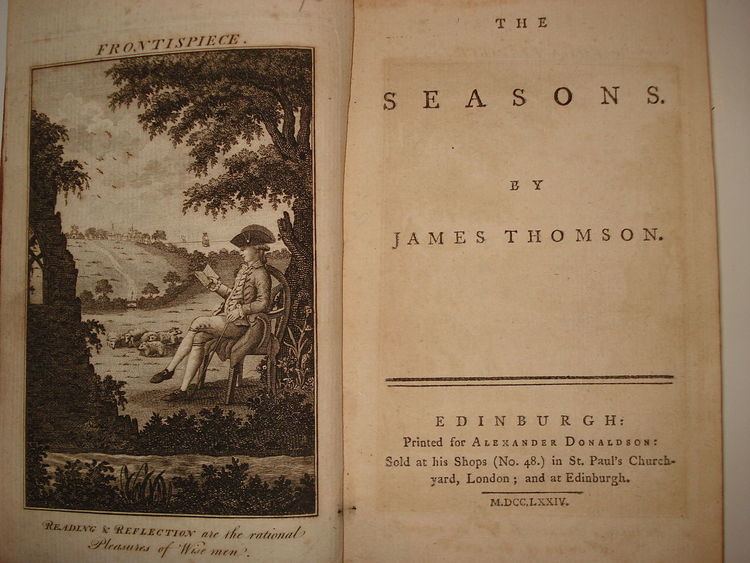 | ||
Similar The Castle of Indolence, Lives of the Most Eminent, Elegy Written in a Country, Georgics | ||
The Seasons is a series of four poems written by the Scottish author James Thomson. The first part, Winter, was published in 1726, and the completed poem cycle appeared in 1730.
Contents
The poem was extremely influential, and stimulated works by John Christopher Smith, Joseph Haydn, Thomas Gainsborough and J. M. W. Turner among many others.
Context
Thomson was educated first at the Parish school of Southdean then at Jedburgh Grammar School and Edinburgh University where he was a member of "The Grotesques" literary club; some of his early poems were published in the Edinburgh Miscellany of 1720. Seeking a larger stage, he went to London in 1725, and became the tutor of Thomas Hamilton (who became the 7th Earl of Haddington) in Barnet. There he was able to begin Winter, the first of his four Seasons.
Blank verse had been considered more of an interesting toy than anything useful to poetry, despite John Milton's epic-scale Paradise Lost and Paradise Regained half a century earlier.
Poem
The poem was published one season at a time, Winter in 1726, Summer in 1727, Spring in 1728 and Autumn only in the complete edition of 1730. Thomson borrowed Milton's Latin-influenced vocabulary and inverted word order, with phrases like "in convolution swift". He extended Milton's narrative use of blank verse to use it for description and to give a meditative feeling. The critic Raymond Dexter Havens called Thomson's style pompous and contorted, remarking that Thompson seemed to have avoided "calling things by their right names and speaking simply, directly, and naturally".
Influence
The lengthy blank verse poem, reflecting on the landscape of the countryside, was highly influential and much liked for at least a century after its writing. Especially lavish editions were produced between 1830 and 1870 in Britain and America.
A dispute over the publishing rights to The Seasons gave rise to two important legal decisions (Millar v. Taylor; Donaldson v. Beckett) in the history of copyright. In 1750, the London bookseller Andrew Millar reprinted the 1746 edition of The Works of James Thomson vol. 1. and included a prefatory note that emphasized the author’s preference for the 1746 edition. Millar may have referred to the 1744 edition because it was the first expanded version of Thomson’s famous poem, it sold quickly, and it may have helped to clarify for Millar that he owned the highly valuable copyright of this book in perpetuity.
Thomson's The Seasons was translated into German by Barthold Heinrich Brockes (1745). This translation formed the basis for a work with the same title by Gottfried van Swieten, which became the libretto for Haydn's oratorio The Seasons.
Artists such as Thomas Medland, Anker Smith and John Neagle (1792) created engravings to accompany the poems. A bathing scene from Summer inspired paintings by Thomas Gainsborough, William Etty (Musidora: The Bather 'At the Doubtful Breeze Alarmed') and Johann Sebastian Bach.
The piece was translated into French by the naturalist Joseph-Philippe-François Deleuze (1753–1835).
